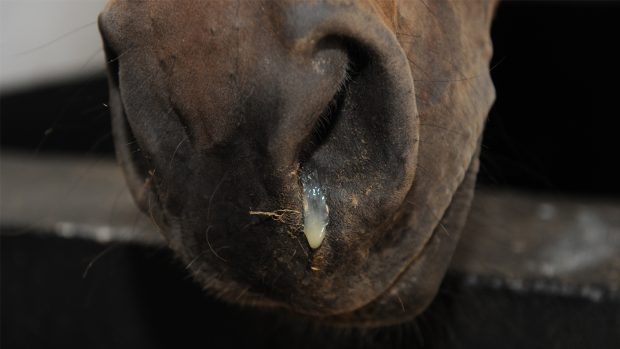Dr Jessica May, the UK lead vet at the video-vet service, FirstVet, shares her recommendations on what horse owners should keep on hand to ensure they are able to deal with any nasty surprises that might crop up during the winter months…
Medicines
It is important to keep an close eye on your horse’s legs during the winter months. Due to the cold weather, a horse’s joints can stiffen and become more prone to injury — especially if they have arthritis. If your horse suffers from musculoskeletal pain, discuss with your vet whether your horse would benefit from some prescription nonsteroidal anti-inflammatory drugs, such as phenylbutazone (bute), to help reduce inflammation when needed.
Owners also need to keep on top of their horses’ parasite control program during the winter, so speak to your vet for advice on how to identify if your horse has a worm burden that requires treatment, and if so, which type of anthelmintics (dewormers) you need to treat them. Deworming products carry different active ingredients to treat specific types of worm so expert advice from your vet or a suitably qualified person is vital.
Creams and ointments
These are important items to have as an owner in order to help wound healing or prevent from bacteria entering wounds. Conditions like mud fever are more prevalent in the winter — due to wet and muddy conditions — and can cause painful sores on a horse’s lower legs. Hydrogel, such as Vetalintex, is a sterile water-based gel that promotes optimal wound healing. This is good in an emergency, as it helps to keep the damaged area clean and moist. Antibacterial creams are also useful to have at hand, as they prevent growth of bacteria, as well as yeast on damaged skin.
Essential winter equipment and tools
With winter comes dark days as well as cold and unpredictable weather. A digital thermometer is always useful to check your horse’s temperature, which should be between 36.8 to 38ºC, as is a stethoscope to listen for the horse’s pulse (normal heart rate should be 36-42 beats per minute). Scissors, disposable gloves, clean buckets, tweezers and towels are also often needed to treat an injury. Finally, a headcollar, lead rope and bailer twine should be in your arsenal — in case you need to catch and tie up a horse quickly to attend to an injury.
Bandages and wraps
Bandaging your horse’s legs if they have suffered an injury or wound not only keeps the wound clean but also prevents further trauma to that area. Every horse owner should know how to apply bandages effectively and safely.
For the primary layer of bandaging you will need non-stick dressings, such as Melolin, to apply directly to the wound, softban to hold the dressing in place, and a roll of cotton wool or gamgee to add a layer of padding on top. Rolled gauze or Knit Firm bandage can be used to hold the cotton wool layer in place. Secondary layers can then be repeated to provide more support to the leg and help to promote healing. Vet wrap is useful for wound dressings and athletic support, but avoid stretching it or else it may become overly tight causing additional damage or pain. Elastoplast or Eband can be used to help prevent the bandage slipping and to stop debris getting into the top or bottom of the bandage. Leg wraps (reusable and washable) should be kept available along with ready-to-use poultices, such as Animalintex, in case you need to draw infection from a wound.
Ice boots
Horse’s joints can be prone to injury in the winter, especially older horses, so ice boots are perfect to have on hand to use after exercising. The ice can help reduce stress on joints, ligaments, and tendons.
Hoof items
Due to the increased moisture in the form of rain or snow, mud can cause of hoof conditions, such as thrush, hoof abscesses, and hoof bruising. Mud makes it easier for small stones to enter a horse’s hoof and get stuck. It is important to use a hoof pick and stiff brush to remove all unwanted debris. Pliers are useful in case a horse pulls a shoe lose and you need to remove it to avoid further damange. Other useful items include a buffer, rasp, wire cutters and bailer twine.
Tape
Duct tape is probably the handiest item you can have during the winter, and all year round. It can be used to tape up a broken rug or used to help secure a poultice on the hoof. Adhesive medical tape can also be used for compression bandages as it will not stick to the horse’s hair and is easily removed.
Grooming kit
A full grooming kit is important to have all year round, but keeping your horse sufficiently groomed over winter is particularly important. This is because, during the winter months, skin conditions caused by things like parasites and lice can arise. By grooming frequently and thoroughly you are able to spot these conditions and treat them quickly.
Clippers
It is important to have a variety of clipper blades as well as the clippers themselves. Obviously clipping a horse is hugely beneficial if a horse regularly works up a sweat while being ridden to avoid them catching a chill as they cool down. A pair of smaller trimmers are also useful so you can clip hair away from around a wound in order to examine it more closely and apply any lotions or creams directly to the injury.
Additional useful items
Always have emergency contact numbers easily available in case you need help urgently. A bright torch is essential during the winter, to help with catching horses in the dark or for inspecting wounds. Head torches can be ideal as they leave your hands free to do other tasks.
For all the latest news analysis, competition reports, interviews, features and much more, don’t miss Horse & Hound magazine, on sale every Thursday.




